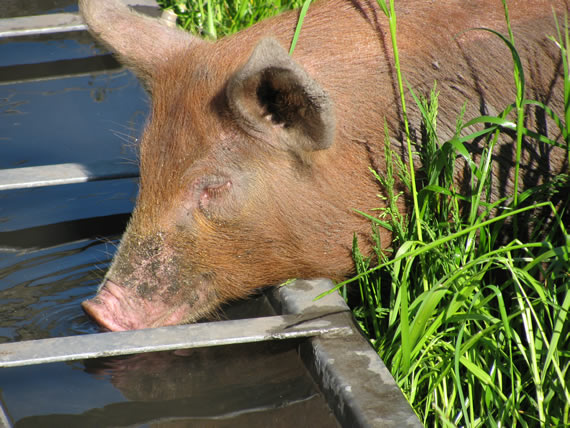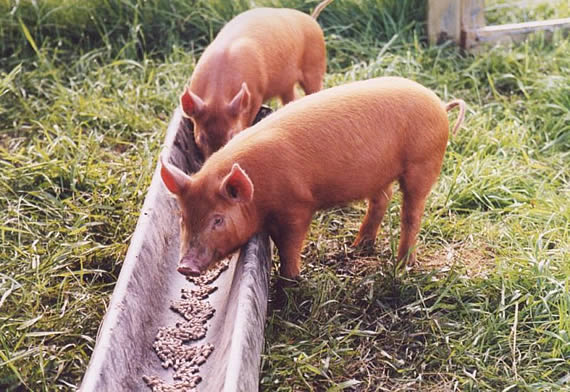How Much Starter Hog Feed Do I Beed
Pigs, like us, are omnivores and will eat a wide variety of foods. Also like us, they need a balanced diet of fibre, energy, protein, vitamins and minerals to thrive. Feed will be your largest expenditure in keeping pigs, so it pays to get it right.
Pigs, like all animals, must have constant access to clean fresh drinking water. As well as tipping the trough to make a wallow, pigs will also stand in the water trough and wash their dirty faces in it, so it needs to be checked regularly, cleaned out and refilled. Galvanised troughs are robust and easy to clean, and not too easy for the pigs to tip over. Automatic drinkers are available but aren't half as much fun for the pigs.
 Tamworth pig drinking
Tamworth pig drinking
If you are clever and have the right equipment, you can mix your own food for your pigs, but most small-scale pig keepers use a commercial pig food. There are many different feed producers including organic and GM free. You will pay a premium for these, but you may be happier doing so. Make sure you have somewhere dry and rodent free to store bags. Once opened, the food should be stored in a rodent proof container. Any spillages should be swept up and removed immediately. Check regularly to ensure that there is no rodent damage to bags – if there is, deal with it immediately.
Always check the best before date on feed; while the feed value will be fine in terms of protein, fibre and oil, the vitamin and mineral levels will decline after it.
Feeding instructions are on the bag but these are for guidance. In cold weather, you may need to increase feed as the pig will use up energy to keep warm. Your best guide is the condition or level of fat cover on your pig.
Regularly check the body condition of your pigs. To do this, run your hand along the spine; if you can feel it clearly, the pig is a bit thin; if you can feel it with firm pressure, it's fine; if you can't feel it at all, the pig is too fat.
How much to feed pigs
As a rule of thumb, you feed 1lb (450g) of food each day for each month of age, up to a maximum of 6lbs (2.75kg) per day. Do not feed more than this - you will waste money and end up with over-fat pigs. Only lactating sows need more food than this. Furthermore, weigh the food. Six pounds is probably less than you think.
As a second rule of thumb, all feed should be cleared up within 20-30 minutes – if not, reduce the amount then increase gradually as appetite increases. On average, taking a weaner from 8 weeks to slaughter six and a half months later will use about 380kg of feed (19 x 20kg bags).
On our Pig Paradise course, there was a couple that had successfully raised two Saddleback weaners and were about to get their second pair. When we were shown how much six pounds of feed was, they were aghast and said that they had been feeding this amount twice per day. They also admitted that their pigs had killed out with about six inches of back fat!
Split the feeds into at least two per day. Pigs like feeding so give them as much fun as possible. If it is very wet underfoot, you may have to use a trough but if it is reasonably dry, scattering the pellets on the ground makes feed-time last longer. If you are using a trough, make sure there is enough space for all the pigs to feed in comfort.
 Feeding weaners in a trough
Feeding weaners in a trough
Supplementing feed with fresh produce
You can supplement the bagged feed with fruit and vegetables but be aware that it is illegal to feed them any catering waste i.e. any food that has been in any kitchen, whether domestic or commercial.
If you are feeding large quantities of fruit and vegetables, reduce the amount of bagged feed on a 1:4 ratio i.e. if you feed 4kg of bananas, reduce the bagged feed by 1kg.
Source: https://www.accidentalsmallholder.net/livestock/pigs/feeding-pigs/